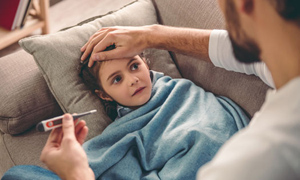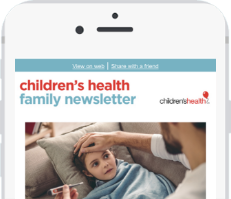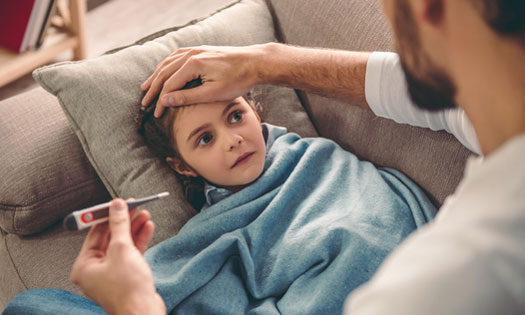Your guide to preventing and treating the flu in children
Believe it or not, children are more likely than adults to get the flu. Learn tips for preventing the flu in children.
Influenza, or the flu, is a respiratory illness caused by a viral infection that affects the lungs, mouth and throat. It isn't the same as stomach flu, which is caused by viruses in the gastrointestinal tract.
The flu is very contagious. Coughing, sneezing, or touching your mouth, eyes or nose can spread it. If your child gets the flu, they are contagious 24 hours before their symptoms appear and then for another 5 to 7 days.
Flu prevention tips for kids
The best way to prevent flu in kids is to make sure everyone in your family (over 6 months old) gets a flu shot.
If your child has been afraid of shots in the past, they may be able to get a nasal spray flu vaccine instead of a shot. The nasal spray flu vaccine is approved for children over the age of 2. Talk to your doctor about whether your child should get the nasal spray flu vaccine and if it's available in their office. These tips for making vaccination visits go more smoothly may also help.
Here are more ways you can help prevent flu in kids and keep your family healthy:
- Practice good hand hygiene with soap and water or hand sanitizer
- Clean and disinfect surfaces
- Teach your child to cough or sneeze into their sleeve or elbow
- Avoid touching your eyes, nose and mouth, as germs spread this way
- Avoid close contact with sick people
- Stay home from school, work and errands when you're sick
Myth: Busted
“I heard my child could get the flu from the flu vaccine. Is that true?”
No. The injectable flu vaccine is an inactivated (killed) virus, so a child CANNOT catch the flu from a flu shot. See the truth behind cold and flu myths.
Symptoms of the flu
At first, the flu can be easily mistaken for a common cold.
If symptoms come on very quickly, it's more likely to be the flu.
Flu symptoms in children include:
- Fever, feverish chills or sweats
- Congestion
- Stuffy or runny nose
- Sore throat
- Coughing
- Headaches
- Muscle or body aches
- Feeling tired and weak
- Vomiting and diarrhea (although these are more common in adults)
When to go to the hospital for flu
The flu can usually be treated at home with rest and lots of liquids.
 If you're concerned about your child's symptoms, call your pediatrician first. They know your child's medical history and specific needs best.
If you're concerned about your child's symptoms, call your pediatrician first. They know your child's medical history and specific needs best.
In some cases, flu symptoms or complications can be serious enough that you need to go to the hospital. Very young children and children with chronic diseases like asthma or diabetes are at higher risk of more serious complications.
It's time to go to the ER if your child:
- Has trouble breathing
- Is not responding or interacting with you
- Has a fever with a rash
- Is vomiting a lot
- Won't drink liquids
- Has blue or gray skin
- Appears dehydrated with dry lips, sunken eyes or decreased urination
- Has symptoms that improved and then returned with a fever and worse cough
Symptoms in newborns can be different from older children.
It's time to go the ER if your newborn:
- Is unable to eat
- Has trouble breathing
- Doesn't have tears when crying
- Is irritable and does not want to be held
- Has fewer wet diapers than normal
Learn more about when to call the doctor and when to take your child to the hospital for the flu.
The number one way to prevent the flu is to ensure everyone in your family gets the flu shot. See 7 ways to prevent the flu via @Childrens.
Learn more
Children's Health Primary Care offers comprehensive health care for children from birth through young adulthood. Our pediatricians combine quality care with evidence-based practice to meet your child’s medical needs. Learn more and find a pediatrician.

Thank you!
You are now subscribed to the Children's Health Family Newsletter.
Children's Health will not sell, share or rent your information to third parties. Please read our privacy policy.
